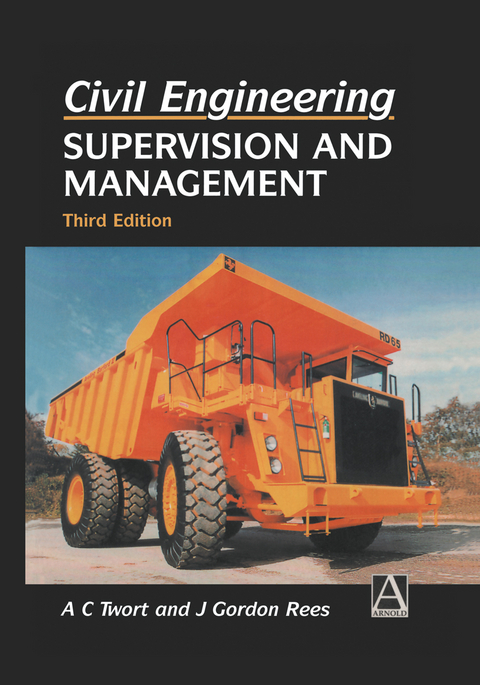
Civil Engineering: Supervision and Management
Butterworth-Heinemann Ltd (Verlag)
978-0-340-64553-6 (ISBN)
This book covers methods adopted for undertaking the design and construction of civil engineering projects. The options for separate design and construction are compared with design and build projects, construction management, and man agement contracting. The salient differences are shown between the various con ditions of contract used. The roles of the engineer, employer's project manager or his representative under different forms of contract are compared. Requirements for the production of contract documents, specifications, tendering procedures and choice of contractor are set out. The engineer's powers and the duties of his resident engineer on the site of con struction are considered in detail. Records, filing systems, programme and progress charts used by the resident engineer are illustrated, and advice is given on the handling of safety problems and difficult situations on site. Problems of measurement and billing of quantities according to the civil engi neering standard method are described. Correct procedures for setting rates for varied work, payment for method-related items, and handling claims for unfore seen conditions under ICE Clause 12 are given. Difficulties with delay claims and situations where the contractor submits quotations before undertaking varied work are discussed. The approach is essentially practical throughout and covers many actual prob lems met on site, including measures that are advisable in relation to site surveys and investigations, construction of earthworks and pipelines, and the production and placing of concrete.
1 Methods of commissioning works.- 1.1 Introduction.- 1.2 Importance of feasibility studies.- 1.3 Overall approaches to design and construction.- 1.4 Options for design.- 1.5 Options for construction.- 1.6 Design and construct and other options.- 1.7 Payment for construction.- 1.8 Nature of risks and their effect on prices.- 1.9 Summary of possible arrangements.- 1.10 Initial cost estimate for a project.- 1.11 Estimating the cost of a project at design stage.- 1.12 Project cost control.- References.- 2 Contractual arrangements.- 2.1 Standard conditions of contract.- 2.2 Conditions for civil engineering work.- 2.3 Conditions for civil engineering or building work.- 2.4 Conditions mainly for plant and equipment supply.- 2.5 A recent report on the UK construction industry: the Latham Report.- 2.6 Roles of the key participants in a construction contract.- 2.7 Contract documents.- 2.8 Writing specifications.- 2.9 Coordinating contracts for construction.- 2.10 Specification of general requirements.- 2.11 Specification for workmanship and materials.- References.- 3 Tendering.- 3.1 Methods used for obtaining tenders.- 3.2 Tendering requirements and EU rules.- 3.3 Procedures under selective tendering.- 3.4 Issuing documents.- 3.5 Considering tenders.- 3.6 Checking prices and comparing tenders.- 3.7 Choosing a tender.- 3.8 Offer by a tenderer to complete early.- 3.9 Procedure for accepting a tender.- 3.10 Bond and insurance.- Publications giving guidance on tendering.- 4 The contractor's site organization.- 4.1 Key site personnel for contractor.- 4.2 The agent.- 4.3 Sub-agents and section engineers.- 4.4 The plant manager or site coordinator.- 4.5 The general foreman.- 4.6 The office manager and his staff.- 4.7 Skilled tradesmen and labourers.- 4.8 Accounting methods.- 4.9 Providing constructional plant and equipment.- 4.10 The contractor's use of subcontractors.- 4.11 Safety requirements.- 4.12 New safety regulations.- References.- 5 The engineer and his staff.- 5.1 The engineer's responsibilities for construction.- 5.2 Limitations on the powers of the engineer.- 5.3 The engineer's design responsibilities.- 5.4 The position held by the resident engineer.- 5.5 Powers and duties of the resident engineer.- 5.6 Some problems of responsibility.- 5.7 Some important points to watch.- 5.8 The resident engineer's responsibilities for safety.- 5.9 Relationship between resident engineer and agent.- 5.10 Handling troubles.- 5.11 More difficult cases of trouble.- 5.12 The resident engineer's staff.- 5.13 Quality assurance.- 5.14 Gifts and hospitality.- References.- 6 Starting the construction work.- 6.1 Pre-commencement meeting and start-up arrangements.- 6.2 The contractor's initial work.- 6.3 The resident engineer's work.- 6.4 Early matters to discuss with the contractor.- 6.5 Some early tasks for the resident engineer.- 6.6 Meeting the employer.- 6.7 Setting up the clerical work.- 7 Site surveys, investigations and layout.- 7.1 Site surveys.- 7.2 Setting out buildings.- 7.3 Setting out larger sites.- 7.4 Setting out floor levels.- 7.5 Site investigations.- 7.6 Trial pits.- 7.7 Test borings.- 7.8 Other means of ground investigation.- 7.9 Judging the safe bearing value of a foundation.- 7.10 Testing apparatus for a site soils laboratory.- 7.11 Site layout considerations.- 7.12 Temporary works.- 7.13 Work in public roads.- 7.14 Site drainage.- References.- 8 The resident engineer's office records.- 8.1 Importance of records.- 8.2 Types of records.- 8.3 Correspondence filing system.- 8.4 CVIs from contractor and instructions to contractor.- 8.5 Register of drawings.- 8.6 Daily and other progress records.- 8.7 Quantity records.- 8.8 The contractor's interim payment applications.- 8.9 Authorization of dayworks.- 8.10 Filing system for dayworks sheets.- 8.11 Check of materials on site.- 8.12 Price increase records.- 8.13 Supply contract records.- 8.14 Registers of test results.- 8.15 Photographs.- 8.16 Record drawings.- 8.17 Other records.- 9 Programme and progress charts.- 9.1 Responsibilities for programming the construction.- 9.2 Alternative ways of handling delivery problems.- 9.3 Role of the resident engineer.- 9.4 Programme considerations.- 9.5 Time schedules.- 9.6 Bar charts.- 9.7 Progress charts.- 9.8 Network diagrams and critical path planning.- 9.9 Part played by the agent in achieving progress.- 9.10 Estimating the probable final cost of works.- 10 Measurement and bills of quantities.- 10.1 Principles of pricing and payment.- 10.2 Methods of measurement for bills of quantities.- 10.3 The ICE standard method of measurement (CESMM).- 10.4 Classification and number of items.- 10.5 Accuracy of quantities: provisional quantities.- 10.6 Billing of quantities for building work.- 10.7 Some problems of billing.- 10.8 Use of nominated subcontractors.- 10.9 Prime cost items.- 10.10 Preliminaries bill and method-related items.- 10.11 Adjustment item to the total price.- 10.12 Preamble to bill of quantities.- 10.13 List of principal quantities.- 11 Interim monthly payments.- 11.1 Handling interim payments.- 11.2 Agreeing quantities for payment.- 11.3 Payment for extra work, dayworks, and claims.- 11.4 Payment of lump sums, method-related items, and any adjustment items.- 11.5 Payment for materials on site.- 11.6 Payment for materials manufactured off site.- 11.7 Payment for manufactured items shipped overseas.- 11.8 Price adjustment.- 11.9 Retention and other matters.- 12 Variations and claims.- 12.1 Who deals with variations and claims?.- 12.2 Payment for increased quantities.- 12.3 Ordered variations.- 12.4 Rates for ordered variations.- 12.5 Variations proposed by the contractor.- 12.6 Claims from the contractor.- 12.7 Sheets submitted 'for record purposes only'.- 12.8 Clause 12 claims for unforeseen conditions.- 12.9 Payment for unforeseen conditions.- 12.10 Delay claims.- 12.11 Estimating delay costs.- 12.12 Quotations from a contractor for undertaking variations.- 12.13 Time limits and interest payable on late payments.- 12.14 Arbitration.- 12.15 Alternative dispute resolution (ADR).- 12.16 Minimizing claims and disputes.- 13 Earthworks and pipelines.- 13.1 Excavating and earth-placing machinery.- 13.2 Controlling excavation.- 13.3 Haulage of excavated material.- 13.4 Placing and compacting fill.- 13.5 Watching fill quantity.- 13.6 Site roads.- 13.7 Trenching for pipelines.- 13.8 Thrust blocks and testing pipelines.- 13.9 Handling and jointing large pipes and fittings.- 14 Site concreting and reinforcement.- 14.1 Development of concrete practice.- 14.2 Standards for concrete quality.- 14.3 Practical compliance with concrete standards.- 14.4 Grading of aggregates and their suitable mixing.- 14.5 Workability of concrete and admixtures.- 14.6 Practical points in producing good concrete.- 14.7 Some causes of unsatisfactory concrete.- 14.8 Site checks on concrete quality.- 14.9 Conveyance and placing of concrete.- 14.10 Construction and other joints.- 14.11 Concrete finish problems.- 14.12 Handling and fixing steel reinforcement.- References.
| Zusatzinfo | X, 246 p. |
|---|---|
| Verlagsort | Oxford |
| Sprache | englisch |
| Maße | 178 x 254 mm |
| Gewicht | 1520 g |
| Themenwelt | Geisteswissenschaften ► Psychologie |
| Medizin / Pharmazie ► Medizinische Fachgebiete ► Psychiatrie / Psychotherapie | |
| Medizin / Pharmazie ► Studium | |
| Technik ► Bauwesen | |
| Wirtschaft ► Betriebswirtschaft / Management ► Projektmanagement | |
| ISBN-10 | 0-340-64553-9 / 0340645539 |
| ISBN-13 | 978-0-340-64553-6 / 9780340645536 |
| Zustand | Neuware |
| Haben Sie eine Frage zum Produkt? |
aus dem Bereich


